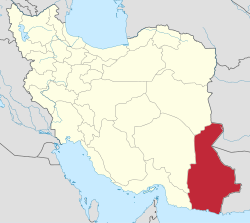Qasr-e Qand
In this article we will explore the fascinating world of Qasr-e Qand and all the different facets that make it up. From its origin and evolution to its impact on today's society, we will immerse ourselves in a journey of discovery and learning. We will analyze its implications in various fields, from science and technology to arts and culture. With a critical and reflective look, we will delve into the positive and negative aspects of Qasr-e Qand, as well as its influence on our daily lives. Join us on this tour and discover everything there is to know about Qasr-e Qand.
Qasr-e Qand
Persian: قصرقند | |
|---|---|
City | |
| Coordinates: 26°14′08″N 60°44′27″E / 26.23556°N 60.74083°E[1] | |
| Country | Iran |
| Province | Sistan and Baluchestan |
| County | Qasr-e Qand |
| District | Central |
| Population (2016)[2] | |
• Total | 11,605 |
| Time zone | UTC+3:30 (IRST) |
Qasr-e Qand (Persian: قصرقند)[a] is a city in, and the capital of, the Central District of Qasr-e Qand County, Sistan and Baluchestan province, Iran, and also serves as capital of the county.[4]
Demographics
Population
At the time of the 2006 National Census, the city's population was 10,826 in 1,586 households,[5] when it was capital of the former Qasr-e Qand District of Nik Shahr County.[6] The following census in 2011 counted 8,563 people in 1,847 households.[7] The 2016 census measured the population of the city as 11,605 people in 2,649 households,[2] by which time the district had been separated from the county in the establishment of Qasr-e Qand County. Qasr-e Qand was transferred to the new Central District as the county's capital.[4]
See also
Notes
References
- ^ OpenStreetMap contributors (12 January 2025). "Qasr-e Qand, Qasr-e Qand County" (Map). OpenStreetMap (in Persian). Retrieved 12 January 2025.
- ^ a b Census of the Islamic Republic of Iran, 1395 (2016): Sistan and Baluchestan Province. amar.org.ir (Report) (in Persian). The Statistical Center of Iran. Archived from the original (Excel) on 23 December 2021. Retrieved 19 December 2022.
- ^ Qasr-e Qand can be found at GEOnet Names Server, at this link, by opening the Advanced Search box, entering "-3079969" in the "Unique Feature Id" form, and clicking on "Search Database".
- ^ a b Rahimi, Mohammad Reza (c. 2023) . Carrying out reforms of national divisions in Sistan and Baluchestan province. qavanin.ir (Report) (in Persian). Ministry of the Interior, Council of Ministers. Proposal 5603/42/1/1. Archived from the original on 22 March 2023. Retrieved 31 December 2023 – via Laws and Regulations Portal of the Islamic Republic of Iran.
- ^ Census of the Islamic Republic of Iran, 1385 (2006): Sistan and Baluchestan Province. amar.org.ir (Report) (in Persian). The Statistical Center of Iran. Archived from the original (Excel) on 20 September 2011. Retrieved 25 September 2022.
- ^ Habibi, Hassan (c. 2022) . Creation and establishment of three districts and one county under the citizenship of Sistan and Baluchestan province as described in the approval letter. rc.majlis.ir (Report) (in Persian). Ministry of the Interior, Political-Defense Commission of the Government Board. Proposal 10140.1.5.53; Letter 907-93808; Notification 119440/T1005. Archived from the original on 21 February 2022. Retrieved 31 December 2023 – via Islamic Council Research Center.
- ^ Census of the Islamic Republic of Iran, 1390 (2011): Sistan and Baluchestan Province. irandataportal.syr.edu (Report) (in Persian). The Statistical Center of Iran. Archived from the original (Excel) on 25 November 2022. Retrieved 19 December 2022 – via Iran Data Portal, Syracuse University.

